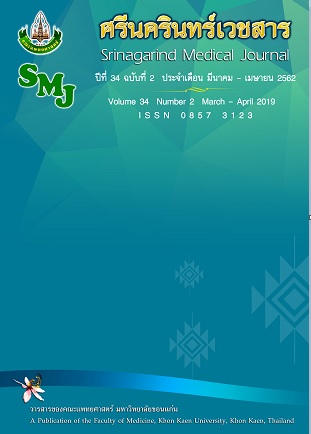Prevalence rate of Congenital Craniofacial Deformities in Chiang Rai Prachanukroh Hospital, Chiang Rai Province
Keywords:
ภาวะปากแหว่งเพดานโหว่, ความพิการแต่กำเนิดของศีรษะและใบหน้า, โรงพยาบาลเชียงรายประชานุเคราะห์, Cleft lip and cleft palate, Craniofacial deformities, Chiang Rai Prachanukroh HospitalAbstract
อัตราความชุกของความพิการแต่กำเนิดของศีรษะและใบหน้าในโรงพยาบาลเชียงรายประชานุเคราะห์ จังหวัดเชียงราย
นฏกร อิตุพร1, อมรรัตน์ รัตนสิริ2*, ฐิติมา นุตราวงศ์3, กุลฑลี บุญประเสริฐ4, สุภาภรณ์ ฉัตรชัยวิวัฒนา5,
ทัศนีย์ ณ พิกุล6
1กลุ่มวิชาการพยาบาลมารดา ทารก และการผดุงครรภ์ คณะพยาบาลศาสตร์ วิทยาลัยเชียงราย
2ภาควิชาเวชศาสตร์ชุมชน คณะแพทยศาสตร์ มหาวิทยาลัยขอนแก่น
3ภาควิชาจุลชีววิทยา คณะแพทยศาสตร์ มหาวิทยาลัยขอนแก่น
4กลุ่มงานสูติ-นรีเวชกรรม โรงพยาบาลเชียงรายประชานุเคราะห์
5ภาควิชาชีววิทยาช่องปาก คณะทันตแพทยศาสตร์ มหาวิทยาลัยขอนแก่น
6หน่วยงานการพยาบาลผู้คลอด โรงพยาบาลเชียงรายประชานุเคราะห์
แหว่ง เพดานโหว่ ปากแหว่งและเพดานโหว่ เป็นความผิดปกติแต่กำเนิดที่พบบ่อยที่สุด ส่งผลกระทบต่อทารกที่มีภาวะดังกล่าว บิดา มารดา และระดับประเทศโดยเฉพาะปัญหาด้านค่าใช้จ่ายในการดูแลรักษาทารกกลุ่มนี้ ผู้วิจัยจึงสนใจที่จะศึกษาอัตราความชุกของภาวะดังกล่าวย้อนหลัง 10 ปี เพื่อนำข้อมูลมาวิเคราะห์และวางแผนแก้ไขปัญหาดังกล่าว
วิธีการศึกษา: เป็นการศึกษาเชิงพรรณนาแบบย้อนหลังจากสมุดลงทะเบียนผู้คลอดที่มาคลอด ณ โรงพยาบาลเชียงรายประชานุเคราะห์ จังหวัดเชียงราย ตั้งแต่เดือนตุลาคม พ.ศ. 2550 – เดือนกันยายน พ.ศ. 2559 โดยทำการเก็บรวบรวมข้อมูลเกี่ยวกับลักษณะความพิการแต่กำเนิดของศีรษะและใบหน้า ได้แก่ ภาวะปากแหว่ง เพดานโหว่ ปากแหว่งและเพดานโหว่ และความผิดปกติของศีรษะและใบหน้าอื่น ๆ และวิเคราะห์ข้อมูลด้วยสถิติเชิงพรรณนา ได้แก่ ความถี่ และร้อยละ และนำเสนออัตราความชุก
ผลการศึกษา: ตั้งแต่เดือนตุลาคม พ.ศ. 2550 – เดือนกันยายน พ.ศ. 2559 โรงพยาบาลเชียงรายประชานุ-เคราะห์มีอัตราความชุกโดยรวมของภาวะปากแหว่ง เพดานโหว่ ปากแหว่งและเพดานโหว่ และความผิดปกติของศีรษะและใบหน้าอื่น ๆ คือ ภาวะโพรงสมองคั่งน้ำ และความผิดปกติของหู เท่ากับ 0.35, 0.31, 0.67 และ 0.61 ตามลำดับ ต่อการเกิดมีชีพ 1,000 ราย
สรุป: ความพิการแต่กำเนิดของศีรษะและใบหน้าที่พบมากที่สุด คือ ภาวะปากแหว่งและเพดานโหว่ สตรีมีครรภ์ควรได้รับความรู้เกี่ยวกับภาวะดังกล่าว และบุคลากรทางการแพทย์ควรมีการรณรงค์ให้สตรีมีครรภ์ได้รับประทานกรดโฟลิก ขนาด 400 ไมโครกรัม วันละ 1 เม็ด ในไตรมาสแรกของการตั้งครรภ์เพื่อป้องกันความพิการแต่กำเนิดดังกล่าวตามนโยบายการฝากครรภ์แนวใหม่ขององค์การอนามัยโลก
Background and Objectives: Congenital craniofacial deformities, particularly, cleft lip; cleft palate; cleft lip and palate are a birth defect that found very frequently. It affects infants with this condition; their parents; the nation because of providing highly budget for caring for these infants. The objectives of this study were to report the prevalence rate of the congenital craniofacial deformities that occurred in the past 10 years and to analyze and suggest the implement health promotion program to reduce this problem.
Method: A retrospective descriptive study was performed in Chiang Rai Prachanukroh Hospital by reviewed birth registration book from October 2007 to September 2016. The data were collected about types of the congenital craniofacial deformities including cleft lip; cleft palate; cleft lip and palate and other abnormalities of face and neck. Descriptive statistics were analyzed by frequency and percentage and presented in the prevalence rate.
Results: During October 2007 to September 2016 found that prevalence of cleft lip; cleft palate; cleft lip and palate and others abnormalities of face and neck such as hydrocephalus and ear abnormally at Chiang Rai Prachanukroh Hospital were 0.35; 0.31; 0.67 and 0.61 per 1,000 live births, respectively.
Conclusion: Most of the congenital craniofacial deformities were cleft lip and palate. The pregnant women should be educated about these conditions and the healthcare providers should provide the prevention program such as advised the pregnant women to take one tablet of 400 micrograms folic acid daily in the first trimester of pregnancy for preventing these conditions followed the WHO new policies about modern antenatal care.
References
Aziza A, Kandasamy R, Shazia S. Pattern of craniofacial anomalies seen in a tertiary care hospital in Saudi Arabia. Ann Saudi Med 2011; 31: 488–93.
Chowchuen B, Thanaviratananich S, Chichareon V, Kamolnate A, Auvichipotchana C, Godfrey C. Multi-center study of oral clefts and associated abnormalities in Thailand: the epidemiologic data and need of health care service. Paper presented at The 10th International Congress on Cleft palate and Related Craniofacial Anomalies; 2005 Sep 4-8; Durban, South Africa.
Panamonta V, Pradubwong S, Panamonta M, Chowchuen B. Global birth prevalence of orofacial clefts: a systematic review. J Med Assoc Thai 2015; 98 (Suppl 7): S11–21.
Watkins SE, Meyer RE, Strauss RP, Aylsworth AS. Classification, epidemiology, and genetics of orofacial clefts. Clin Plast Surg 2014; 41: 149–63.
บวรศิลป์ เชาวน์ชื่น, ผกาพรรณ เกียรติชูสกุล. คู่มืออุบัติการณ์ สาเหตุ การป้องกัน ภาวะปากแหว่ง เพดานโหว่ และความพิการแต่กำเนิดของศีรษะและใบหน้า: ทำความรู้จัก ทราบสาเหตุ อุบัติการณ์ และ การป้องกัน. ขอนแก่น: ศูนย์วิจัยผู้ป่วยปากแหว่ง เพดานโหว่ และความพิการแต่กำเนิดของศีรษะและใบหน้า คณะแพทยศาสตร์ มหาวิทยาลัยขอนแก่น; 2554.
สมาคมเพื่อเด็กพิการแต่กำเนิด (ประเทศไทย). คู่มือปฏิบัติการในระดับโรงพยาบาล โครงการปฏิบัติการระดับชาติเพื่อวางแผนป้องกันและดูแลรักษาความพิการแต่กำเนิดในประเทศไทย. [Cited May 21, 2018]. Available from: https://bit.ly/2SXbRPV
Newborn with cleft lip/palate (CLP).ASTV Manager Online [Internet]. 2015 Jan 18 [Cited Mar 1, 2018]. Available from: https://goo.gl/BDEypM
Pradubwong S, Lekbunyasin O, Chantachum V, Udomtanasup S, Simmalee K, Chowchuen B. Application of Geographic Information System (GIS) for management of cleft lip-palate care at the Tawanchai Cleft Center. J Med Assoc Thai 2010; 93 (Suppl 4): S58–62.
พิษณุ ขันติพงษ์. เอกสารประกอบการประชุม การดูแลหญิงตั้งครรภ์แนวใหม่ตามข้อแนะนำองค์กรอนามัยโลก วันที่ 23 ธันวาคม พ.ศ. 2554. เชียงราย: โรงพยาบาลเชียงรายประชานุเคราะห์; 2554.
จำรัส วงศ์คำ, ถวัลย์วงค์ รัตนสิริ, มาสินี ไพบูลย์, พรรณวดี ชาติวิเศษ, นุชวรา สุทธิศรี, ปิยะมาศศักดิ์ศิริวุฒโฒ, และคณะ. ความรู้และทัศนคติในการรับประทานกรดโฟลิกเพื่อป้องกันความพิการแต่
กำเนิดของสตรีมีครรภ์. ศรีนรินทร์เวชสาร 2559; 31: 192–6.
อาภาวรรณ โสภณธรรมรักษ์. 5 โรคพิการแต่กำเนิด ป้องกันได้ด้วย “โฟลิก” [ออนไลน์]. 22 กุมภาพันธ์ 2560 [ค้นพบเมื่อ 8 พฤศจิกายน 2561]. แหล่งที่มา: https://bit.ly/2lbj65F


